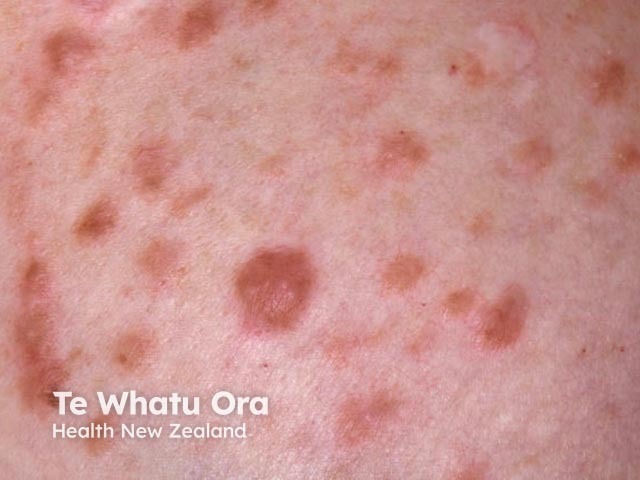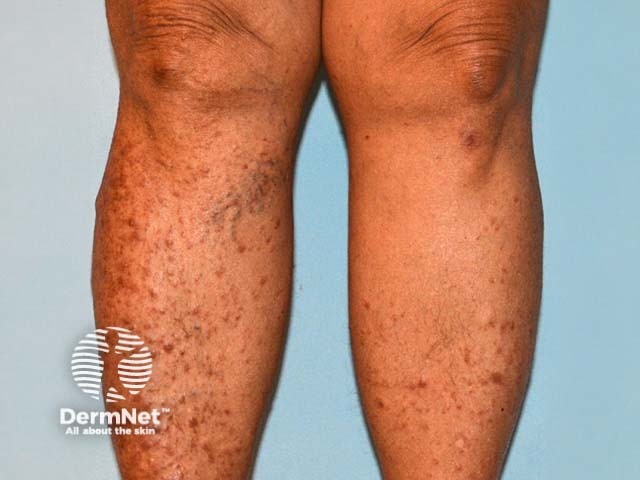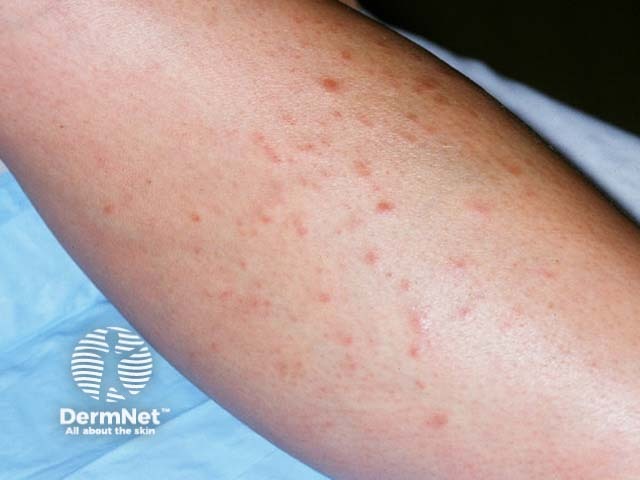Main menu
Common skin conditions

NEWS
Join DermNet PRO
Read more
Quick links
Author: Dr Ben Tallon, Dermatology Registrar, Greenlane Hospital, Auckland, New Zealand, 2008.
Hereditary leiomyomatosis and renal cell cancer syndrome is a rare condition that was first formally recognised in 2001. It is now reported to affect over 105 families worldwide. Features of the syndrome include:
The hereditary leiomyomatosis and renal cell cancer syndrome is also known as Reed syndrome, multiple cutaneous and uterine leiomyomata type 1, and hereditary leiomyomata and renal cell carcinoma.

Cutaneous leiomyomatosis

Cutaneous leiomyomatosis

Cutaneous leiomyomatosis
Cutaneous leiomyomas or piloleiomyomas appear as small (0.5–2 cm) firm skin coloured nodules. They arise from the arrector pili muscles which are responsible for making hairs stand on end. Multiple lesions may develop, often in clusters and commonly in a segmental distribution. These nodules are benign, so are only of concern because of their appearance or their tendency to be tender if knocked.
Occasionally multiple cutaneous leiomyomas may also arise in association with Gardner syndrome, HIV infection, chronic lymphocytic leukaemia and polycythaemia.
The uterine leiomyoma is also known as a fibroid and is the most common premenopausal tumour in women. In the hereditary leiomyomatosis and renal cell cancer syndrome, fibroids occur earlier than usual and are frequently larger and more likely to cause excessive bleeding and pain with menstruation. While the majority are benign, there is an increased risk of malignancy (leiomyosarcoma) developing, and some appear atypical down the microscope.
Renal cell carcinoma is the most concerning feature of hereditary leiomyomatosis and renal cell cancer syndrome, though this does not occur in all individuals with the disease. It is thought that just some mutations are associated with the development of renal cell cancer. Unfortunately, the renal cell cancers that develop in this syndrome tend to be aggressive and appear at an early age. They are histologically papillary type 2. Unlike other renal cell cancer syndromes (see von Hippel Lindau syndrome and Birt-Hogg-Dubé syndrome) they are more commonly unilateral and solitary.
The gene responsible for hereditary leiomyomatosis and renal cell cancer syndrome has been identified as the fumarate hydratase gene. This gene is thought to act as a tumour suppressor. The fumarate hydratase enzyme functions in the cell energy pathway called the Krebs cycle. How this causes the clinical features is not entirely understood.
Many mutations in this gene are known to occur, which all result in the syndrome being inherited in an autosomal dominant fashion. That means that an affected individual may pass it on to roughly half of his or her sons and daughters. Consultation with a geneticist may be advisable given the importance of other family member involvement.
There is no means to repair the gene mutation. Treatment is focussed around the detection and prevention of cancer.
Current advice is to have regular imaging of the kidneys. There has been a suggestion that the renal tumours in this syndrome are not seen early on ultrasound, so an MRI scan is usually required.
Affected women should seek a consultation with a gynaecologist, especially if they have heavy bleeding or pain with menstruation. If they have a large fibroid, it may need to be removed for symptomatic reasons. Regular uterine screening should be encouraged. Once they have finished having children, they may wish to consider hysterectomy (removal of the uterus) to reduce the risk of uterine cancer.
As the hereditary leiomyomatosis and renal cell cancer syndrome is inherited, it is vital that all family members are informed and seen by a doctor with expertise in this area. Genetic testing is available with a simple DNA sample (blood or buccal smear).
Some cases may require treatment for the pain of the cutaneous leiomyomas. The following have been reported to be helpful: